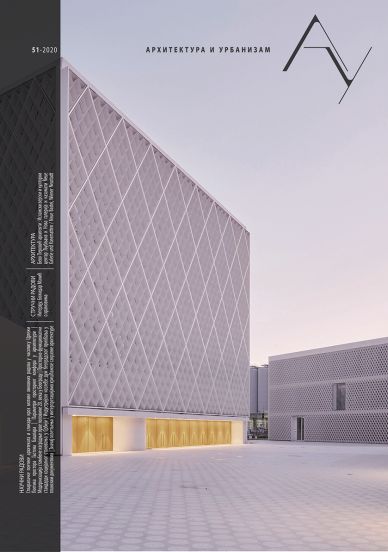Spatial and functional standards of social housing in Serbia: regulations, practice and users’ perception
Abstract
Adequate level of housing comfort, in terms of space, function and health, is one of the key factors of quality and sustainability of social housing. In post-socialist Serbia, the extremely residual system of provision in this sector has been a major challenge to achieve adequate quality standards for new social housing construction over the past two decades. Through a review of the national regulations in the field of planning, design and construction of social housing after 2000 and the results of the conducted empirical research on six completed projects (in Valjevo, Pančevo, Čačak, Kraljevo, Kragujevac and Belgrade), the paper discusses the situation, limitations and opportunities for improving current housing practices in this field. In the initial period of formation of the new housing system, through the recommendations for planning and design social housing was treated as below average standard and quality housing, but since 2009 its development through the legislative framework is increasingly directed towards the concept of sustainable housing development. At the same time, the results of the evaluation of the pioneering examples of practice in this area, realized in the period 2008-2010, indicate certain deficiency in terms of the application of sustainability criteria. Through a survey of tenants on satisfaction with various elements of housing comfort, the problems of overcrowding and inadequacy of housing conditions regarding functional and health aspects were observed in selected examples. It was found that the tenants are mostly satisfied with the level of thermal and light comfort in the apartments, while they expressed significant dissatisfaction due to the lack of auxiliary and open apartment areas, insufficient sound insulation and overall lower quality construction. In the concluding remarks, the results of the research are discussed and recommendations are given for the improvement of design standards and monitoring instruments in social housing programs in Serbia.
References
Bajić, T., Manić, B. (2018a) Urban architectural competition as an instrument for realization of the social housing projects in post-socialist Belgrade. In Bolay, J.C., Maričić, T., Zeković, S. (eds.) A Support to Urban Development Process, EPFL and IAUS, 108-128.
Bajić, T. (2017) Kriterijumi u urbanističkom planiranju i projektovanju socijalnog stanovanja u Srbiji, Doktorska disertacija. Beograd: Univerzitet u Beogradu, Arhitektonski fakultet.
Bajić, T., Manić, B., Kovačević, B. (2014) Socijalno stanovanje u Beogradu: praksa arhitektonsko-urbanističkih konkursa (2003-2014). Arhitektura i urbanizam, 39, str. 29-43.
Chiu, R. L. H. (2003) Sustainable development: A new perspective for housing development. The University of Hong Kong.
Čolić Damjanović, V. M. (2015) Unapređenje modela socijalnog stanovanja u Beogradu u okviru novih paradigmi planiranja i projektovanja, doktorska disertacija. Beograd: Arhitektonski fakultet Univerziteta u Beogradu.
Damjanović, D., Gligorijević Ž. (2010) (ur.) Socijalno stanovanje. Prikaz stambenih politika Srbije i odabranih zemalja Evrope. Beograd: PALGO centar.
Generalni urbanistički plan Beograda 2021 („Sl. list grada Beograda“, br. 27/03).
Harloe, M. (1995) The People’s Home: Social Rented Housing in Europe and America. Oxford: Blackwell Publishiers.
Jovanović-Popović, M. (1991) Zdravo stanovanje. Beograd: Arhitektonski fakultet Univerziteta u Beogradu.
Manasijević Radojević, M., Kulačin, B. (2020) Stambeno zbrinjavanje izbeglih i raseljenih lica sa prostora bivše SFRJ i na primeru Novog Sada - od analize prostornih potencijala, preko plana do realizacije. U Jevtić, A., Drašković, B. (ur.) Budućnost gradova i urbanizma, Zbornik radova sa Međunarodnog naučno-stručnog skupa 16. Letnja škola urbanizma, Prolom Banja, 1-3. jul 2020, Beograd: Udruženje urbanista Srbije, str. 107-114.
Milić, V. (2002) Istraživanje obrazaca pristupačnog stanovanja u okviru novog modela urbanističkog planiranja, doktorska disertacija. Beograd: Arhitektonski fakultet Univerziteta u Beogradu.
Milić, V. (2006) Urbanistički aspekti socijalnog stanovanja. Beograd: Arhitektonski fakultet.
Newman, P. (2002) Sustainability and housing – more than a roof over head. Barnett Oration, Melbourne.
Nacionalna strategija socijalnog stanovanja (2012) („Sl. glasnik RS“, br. 13/2012).
Nacionalna stambena strategija od 2020. do 2030. godine (Nacrt), https://www.mgsi.gov.rs/sites/default/files/Nacionalna%20stambena%20strategija_NACRT_0.pdf, pristupljeno 30.09.2020.
Pravilnik o uslovima i normativima za planiranje i projektovanje stambenih zgrada i stanova u programima stambene podrške („Sl. glasnik RS, br. 76/2017)
Prostorni plan Republike Srbije do 2020. godine („Sl. glasnik RS“, br. 88/2010).
Ramirez, L., Mojović, Đ., Galassi, B., Čolić, R. (ur.) (2008) SIRP Book: The Settlement and Integration of Refugees Programme in Serbia 2005-2008 / Knjiga o SIRP-u - Program stanovanja i trajne integracije izbeglica u Srbiji 2005-2008. Beograd: UN-HABITAT.
Republički zavod za statistiku (RZS) (2015) Prihodi i uslovi života u Republici Srbiji ‒ 2013. Finalni izveštaj. Beograd: Republički zavod za statistiku.
Reeves, P. (2005) An introduction to social housing. Oxford: Elsevier.
Strategija održivog urbanog razvoja Republike Srbije do 2030. godine („Sl. glasnik RS“, br. 47/2019).
UN CESCR (1991) General Comment No. 4: The right to adequate housing (Art. 11(1) of the Covenant), 13 December 1991, E/1992/23. http://www.refworld.org/docid/47a7079a1.html, pristupljeno 04.09.2020.
UNECE (2006) Guidelines on Social Housing. Principles and Examples. New York and Geneva: United Nations. https://www.unece.org/fileadmin/DAM/hlm/documents/Publications/guidelines.social.housing.pdf, pristupljeno 04.09.2020.
UNECE (2015) Social Housing in the UNECE region. Models, Trends and Challenges. Geneva: United Nations.
UNECE (2015a) The Geneva UN Charter on Sustainable Housing. Ensure access to decent, adequate, affordable and healthy housing for all. https://www.unece.org/fileadmin/DAM/hlm/documents/Publications/UNECE_Charter_EN.pdf, pristupljeno 04.09.2020.
UNEP (2013) Sustainable Solutions for Social Housing. Guidelines for project developers. http://www.unep.org/sustainablesocialhousing/pdfs/SUSHI_Guidelines_2013.pdf, pristupljeno 30.02.2015.
UN-HABITAT (2012) Sustainable Housing for Sustainable Cities – A policy framework for developing countries. Nairobi: UN-HABITAT.
Urbanistički zavod Beograda (2003) Predlog tehničkog pravilnika za planiranje i projektovanje kompleksa i stanova socijalne izgradnje. Beograd: Urbanistički zavod Beograda (nije usvojen).
Uredba o standardima i normativima za planiranje, projektovanje, građenje i uslovima za korišćenje i održavanje stanova za socijalno stanovanje („Sl. glasnik RS“, br. 26/2013).
Vesić, U. (2015) Energetska efikasnost modela materijalizacije objekata socijalnog stanovanja u Srbiji, doktorska disertacija. Beograd: Arhitektonski fakultet Univerziteta u Beogradu.
Vuja, A. (2019) Ka višem kvalitetu socijalne stanogradnje u Srbiji: Objekat za socijalno stanovanje u Požarevcu, Arhitektura i urbanizam, 49, str. 70-75.
Zakon o socijalnom stanovanju („Sl. glasnik RS“, br. 72/2009).
Zakon o stanovanju i održavanju zgrada („Sl. glasnik RSˮ br. 104/2016).
WHO (1989) Health principles of housing. Geneva: World Health Organization, https://apps.who.int/iris/bitstream/handle/10665/39847/9241561270_eng.pdf?sequence=1&isAllowed=y, pristupljeno 15.08.2020.
Copyright (c) 2020 Arhitektura i urbanizam

This work is licensed under a Creative Commons Attribution-ShareAlike 4.0 International License.

